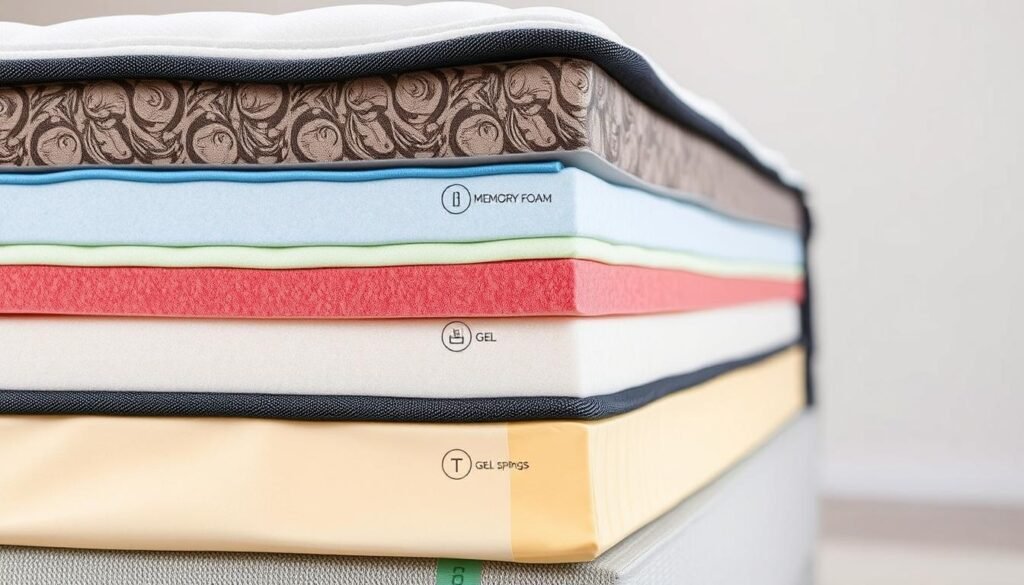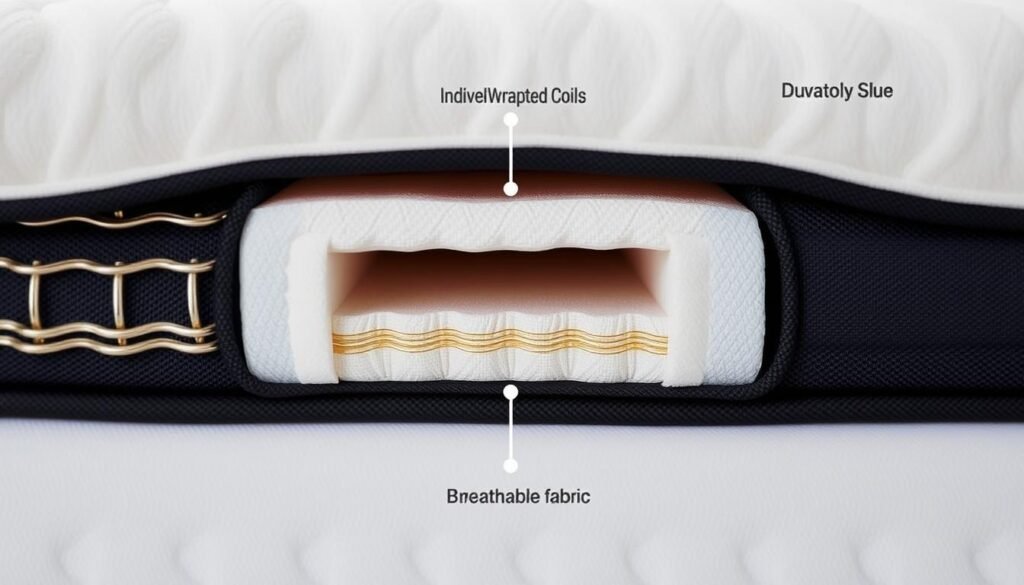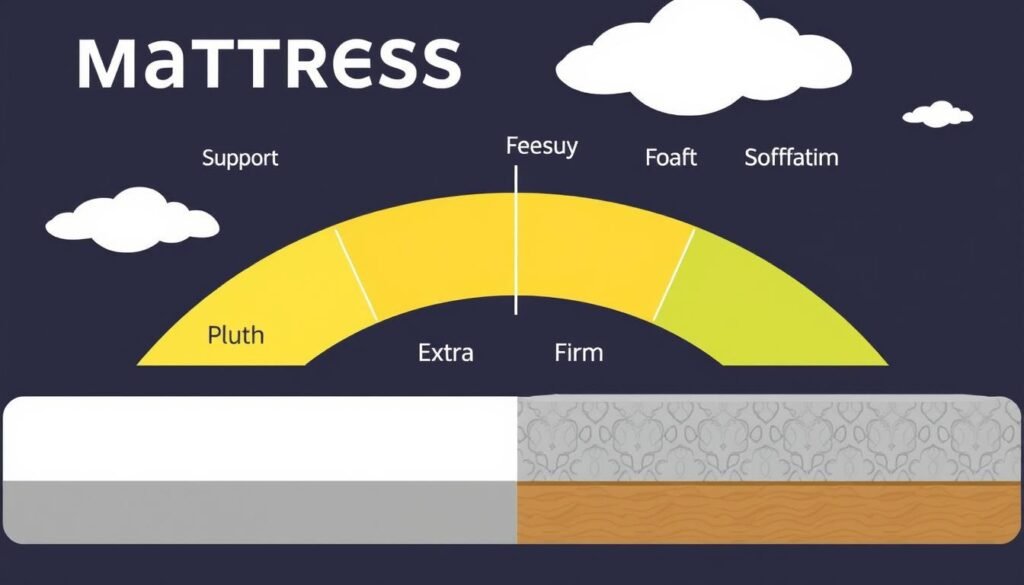Did you know the global mattress market is set to hit $43.4 billion by 20271? This huge growth shows how vital it is to make top-notch mattresses. We’ll explore the details of mattress design, sharing expert tips to craft a bed that’s comfy, supportive, and lasts long.
Creating a mattress is a detailed task. It needs a solid grasp of materials, ergonomics, and sleep science. Choosing the right foams, coil systems, and fabrics is key. Each part of the design affects how well the mattress works and feels to users23.
Key Takeaways
- Designing a high-quality mattress requires a careful balance of materials, ergonomics, and sleep science.
- The selection of foam densities, coil systems, and upholstery methods can significantly impact the comfort and support of the mattress.
- Incorporating breathable fabrics and regulating temperature are essential for ensuring a comfortable and restorative sleep experience.
- Customizing the mattress design to accommodate various body types and sleep positions is critical for optimal comfort and spinal alignment.
- The iterative design process, including prototyping and testing, is key to refining the mattress design and ensuring it meets the diverse needs of consumers.
Understanding the Foundations of Mattress Design
Creating a top-notch mattress starts with knowing the materials and how they’re put together. The materials, from the base to the soft layers, greatly affect how the mattress feels and works.4 It’s also key to think about ergonomic design to make sure the mattress fits your sleep style.
The Role of Materials in Mattress Construction
Different materials are used in mattresses, each bringing its own benefits. Most mattresses have one or two soft layers, but some have three or more.1 The thickness of these layers matters too. Firm mattresses have 1 to 2 inches of soft material, while softer ones can have 4 inches or more.1 A mid-firm mattress usually has 2 to 3 inches of soft layer.1
Ergonomics and Sleep Posture: Considerations for Optimal Comfort
The design of a mattress also plays a big role in comfort and support. Transitional layers are 1 to 3 inches thick,1 and the base is the thickest part, between 6 and 10 inches.1 These parts work together to match the mattress to your natural sleep position, easing pressure points and keeping your spine straight.
Most mattresses are between firmness levels 3 (soft) and 8 (firm), with4 medium (5) and medium firm (6) being the most common.1 Most are between 10 and 15 inches thick.1 Some mattresses, called flippable mattresses, have different sides for different firmness levels.1
By understanding materials, construction, and design, we can make mattresses that offer the best comfort and support for a good night’s sleep.
| Mattress Foundation Type | Key Considerations |
|---|---|
| Box Springs | Box springs are often designed to pair with spring mattresses because memory foam or latex mattresses sink between the support slats.2 |
| Platform Beds | Platform beds are simple and often have built-in storage, making them a lower profile bed.2 |
| Slatted Foundations | Slatted foundations don’t always need a box spring, but it’s wise to check the manufacturer’s advice first. Wood slatted foundations, while cheaper than metal, may bend over time.2 |
| Platform Bases | Metal platform bases are affordable and don’t need a box spring, providing extra support with horizontal metal slats.2 |
| Bunkie Boards | Bunkie boards are solid pieces, usually wood or particleboard, placed on a slatted foundation for more support without raising the bed height.2 |
| Adjustable Bases | Adjustable bases, the most expensive option, offer health benefits like easing back and joint pain, helping with acid reflux, snoring, improving blood flow, and aiding sleep apnea. Factory Mattress has a wide range of adjustable mattress bases.2 |
In conclusion, mattress design is all about finding the right mix of materials, construction, and ergonomic design. This creates a sleep surface that offers the best comfort and support for you45.
Crafting the Perfect Comfort Layers
The secret to a great night’s sleep is in the comfort layers of a mattress. These layers give the mattress its soft, hugging feel. They also help ease pressure points6. We’ll look at how different foams and latexes, along with fancy quilting and upholstery, make a mattress feel like a luxury bed.
Exploring Different Foam and Latex Densities
Density is important for mattress comfort. Thicker foams and latexes hug your body better and relieve pressure. Thinner ones breathe better and respond quickly7. We mix these to make a mattress that fits just right for you, no matter your body type.
We use everything from soft memory foam to firm natural latex7. Our goal is to give you the best comfort and support.
Quilting Patterns and Upholstery Methods for Plush Surfaces
The mattress’s surface is also key for a luxurious feel. Fancy quilting and careful upholstery turn a basic mattress into a luxury retreat6. We use everything from elegant diamond patterns to plush pillow-tops. Our focus is on making every part of the mattress inviting.
By perfecting the comfort layers, we make sleep better. You’ll wake up feeling new and refreshed6. Whether you like foam’s hug or latex’s spring, we’ve got the right mix for you.

Incorporating Support Systems for Lasting Durability
Creating a mattress that lasts requires careful planning. It needs strong support systems. These systems keep the mattress solid and comfy for years, giving users great sleep8.
The core of a mattress, made of coils, foam, or both, is key. It must match the user’s weight and how they sleep. For example, heavy people might need a coil core that can handle their weight9.
The comfort layers also matter a lot. They’re usually 1 to 5 inches thick and make the mattress feel soft and supportive. Choosing the right materials and thicknesses helps the mattress stay comfy for a long time8.
Adding extra layers or foam around the edges helps too. These features stop the mattress from sagging. They keep support even where it’s most needed, like the edges8.
By focusing on a strong support system, mattress makers can make products that are both comfy and long-lasting. These mattresses give users a great sleep experience for years10.
| Mattress Feature | Contribution to Durability |
|---|---|
| Support Core | Provides the primary support and structural integrity, with coil-based systems showing more durability for heavier sleepers. |
| Comfort Layers | Keep the mattress soft and supportive over time, with thicker layers being more durable. |
| Reinforcement Strategies | Boost the mattress’s strength, like with transition layers and edge support, to stop sagging and keep support even. |

“Investing in a high-quality mattress with a robust support system is one of the best decisions you can make for your long-term sleep health and comfort.”
how to design a mattress
Designing a mattress is a detailed and ongoing process. It involves making prototypes, testing them, and making improvements11. This way, we can make a mattress that really meets your needs and likes. Knowing about this process helps you pick or make a mattress that’s just right for you.
Prototyping and Testing: The Key to Perfection
We start by making many prototypes. Each one is a bit different in materials, how it’s made, and how firm it is11. This lets us try out different ideas and find the best mix of comfort and support11. Then, we test these prototypes a lot. We listen to what people say and check how well they work, to make sure they’re top-notch.
We ask people with different body types and sleep styles to try the prototypes. They tell us about things like how well the mattress relieves pressure and how comfortable it is12. We use this feedback to make the mattress even better.
We also do scientific tests to check how the mattress does11. We look at things like how long it lasts, how it keeps you cool, and how it moves with you11. By using both what people say and what the tests show, we get a full picture of the mattress’s strengths.
This back-and-forth of making and testing helps us create a mattress that looks good and feels great12. We pay close attention to every detail and keep improving. This way, the mattress we make is a true sign of our commitment to giving you a great night’s sleep.
By following this design process, we can make a mattress that fits your exact needs. Whether you sleep on your side, back, or a mix, we can make something perfect for you11. The possibilities are endless when you focus on the design journey and aim for the perfect mattress for your sleep space.
Striking the Balance: Firmness, Support, and Pressure Relief
Finding the right balance in mattress design is a complex task. It’s important to know about different body types and sleep positions. This knowledge helps in making a mattress that suits everyone’s needs for a good night’s sleep.
Understanding Body Types and Sleep Positions
The right mattress firmness depends on your body type and how you sleep. Medium-firm mattresses are often seen as the best, as they offer good cushioning and support13. But, people with certain needs, like side sleepers or those with chronic back pain, might need softer or firmer mattresses for better pressure relief and spine alignment14.
Side sleepers usually do well with a medium-soft to medium-firm mattress, which is about 4 to 6.5 on the firmness scale. This helps with even pressure and comfort13. Back sleepers often prefer a medium-firm to firm mattress, between 6.5 to 8, to keep their spine aligned13. Stomach sleepers need a firm mattress, around 7.5 to 9, to prevent their hips from sinking too much and keep their spine straight13.
It’s also key to consider your weight. Lighter people might find medium-firm mattresses comfy, while heavier people might need a firmer one, about 8 to 9, for better support and pressure relief13. People with chronic back pain or joint issues should pick a mattress firmness that meets their health needs14.
For combination sleepers, who switch positions during the night, a medium-firm mattress, around 6.5, offers a good balance of cushioning and support13.

“Achieving the perfect balance between firmness, support, and pressure relief is a key part of mattress design.”
By knowing the different needs of sleepers and designing mattresses with these in mind, we can make sleep surfaces for everyone. This ensures a sleep experience that’s both personalized and refreshing1413.
Mattress Size and Shape: Customizing for Individual Needs
Not everyone fits into the same mattress size. The size and shape of a mattress are key to a good night’s sleep. At Custom Mattress Makers, we help you find the perfect mattress for your needs.
People spend about 25 years sleeping, which is a third of their lives15. Having a mattress that supports your body and fits your space is vital. Custom mattresses come in unique sizes and shapes, unlike standard ones15.
These mattresses can be made to fit special spaces, like small bedrooms or RVs15. You can even get mattresses with custom corners for antique bed frames15.
The price of custom beds depends on size, materials, and extra features16. High-quality materials like organic latex or memory foam can increase the cost16. Larger or unusual sizes also cost more due to more materials and labor16.
At Custom Mattress Makers, we’re proud to offer mattresses tailored to your needs15. Our team works with you to create a mattress that looks great and feels amazing15.
Looking for a mattress for your RV or a unique sleeping space? Custom Mattress Makers can help15. We’re dedicated to quality and innovation, aiming to make your sleep experience the best15.
“Customized corners, including angled, notched, or rounded cuts, are common in RVs, campers, trailers, or antique bed frames.”
Enhancing Breathability and Temperature Regulation
Getting a good night’s sleep is more than just the firmness of your mattress. It’s also about how well it breathes and keeps your body temperature just right. The right materials and design can make your mattress a cool, comfortable place to sleep all night.
Choosing the Right Materials for Cool Sleep
The materials used in making a mattress are key for keeping you cool and comfortable. Memory foam, for example, molds to your body but can get hot17. To fix this, many use breathable materials like polyfoam or latex17. Hybrid mattresses, with foam and coils, also help keep you cool by letting air through17.
The fabrics used in a mattress also matter for breathability. Natural fibers like wool help keep you cool by drawing moisture away18. Synthetic blends, like polyester, can also improve airflow and keep you comfortable.
| Mattress Type | Temperature Regulation Performance |
|---|---|
| Memory Foam | Tends to retain heat and trap it against the body17 |
| Polyfoam | Generally has better air circulation than traditional memory foam17 |
| Latex | Offers better temperature neutrality than memory foam due to their breathable nature17 |
| Hybrid | Microcoils can enhance temperature regulation due to their ability to allow air to filter through17 |
| Innerspring | Excels at temperature regulation as air can circulate between the coils17 |
| All-Foam | Tend to retain heat more than other types due to limited air circulation in their high-density polyfoam cores17 |
| Airbed | Maintain room temperature more effectively due to the air in their chambered support systems naturally adjusting to ambient conditions17 |
By picking materials that focus on breathability and keeping you cool, mattress makers can create a better sleep space. This space keeps you comfortable all night, without the hassle of being too hot or cold.
Conclusion
Designing a top-notch mattress is all about finding the right mix of comfort, support, and durability. We’ve looked into the basics of mattress design. This includes creating the perfect comfort layers, adding strong support systems, and making sure the mattress breathes well and keeps a comfortable temperature. This way, we can make a mattress that really meets our customers’ needs19.
The design process is a journey that involves knowing about body types, sleep positions, and personal preferences. By following the tips and techniques from this article, we can make a mattress that goes beyond what people expect20.
In mattress construction and mattress manufacturing, finding the right balance is key. Using the insights and data-driven methods from this guide, we can create mattresses that not only meet but also exceed today’s sleep needs1920.
FAQ
What are the essential elements of mattress design?
How do materials and construction techniques contribute to the overall feel and performance of a mattress?
What is the role of comfort layers in a mattress design?
How can mattress design ensure long-term durability and performance?
What is the importance of the iterative design process in mattress development?
How can mattress design address the diverse needs of different body types and sleep positions?
How can mattress size and shape be customized to meet individual needs?
What design elements contribute to the overall breathability and temperature regulation of a mattress?
Source Links
- How to Make Your Bed Like a Designer — Homzie Designs – https://www.homziedesigns.com/blog/how-to-make-your-bed-like-a-designer
- Mattress Construction – https://sleepdoctor.com/best-mattress/mattress-construction/
- How Mattresses Are Made- What’s Inside Might Surprise You – https://themattressbuyerguide.com/a-mattress-designers-secrets/
- Mattress Construction – https://www.sleepfoundation.org/mattress-construction
- A Breakdown of Mattress Foundations – https://factorymattresstexas.com/blog/a-breakdown-of-mattress-foundations/
- How to Layer and Style a Bed like a Designer – https://www.tidbits-cami.com/style-bed-like-designer/
- How to Make Your Own DIY Mattress in 6 Steps – TheRoundup – https://theroundup.org/how-to-make-your-own-diy-mattress/
- Mattress Comfort Layers – https://www.sleepfoundation.org/mattress-construction/mattress-comfort-layers
- Mattress Support Cores – https://www.sleepfoundation.org/mattress-construction/mattress-support-core
- What is Edge Support in a Mattress, and Why is it Important? – https://mlilyusa.com/mattress-guides/what-is-edge-support-in-a-mattress/
- DIY Mattress: Your Complete Guide to Making Your Own Mattress | Sleepopolis – https://sleepopolis.com/diy-mattress/
- Design Your Own Mattress – https://foam4u.co.uk/product/design-your-own-mattress/
- Mattress Firmness Guide – Which Firmness Is Right For Me? – https://sleepopolis.com/guides/mattress-firmness-guide/
- Understanding Mattress Firmness for Ultimate Comfort & Support – https://thebeddingmart.com/blogs/news/understanding-mattress-firmness-for-ultimate-comfort-support
- Custom Mattress Guide – https://custommattressmakers.com/pages/custom-mattress-guide?srsltid=AfmBOop41Ako5ts3Up8shCngCMwjBwlde8r8NEeqge386hnIkkz_1NBL
- How to Make a Custom Size Mattress: Tailoring Sleep to Your Unique Needs – https://puffy.com/blogs/best-sleep/how-to-make-a-custom-size-mattress?srsltid=AfmBOopVQBAOXhoGf46cDkUIk_sp48E11JlJfGGkxbseafMfYRVVrNMz
- Temperature Control – https://www.sleepfoundation.org/research-methodology/temperature-control
- Enhancing Sleep Quality with a Breathable Mattress: A Guide – https://nobullmattress.com/mattress-breathability/?srsltid=AfmBOoo7rg5MxGUgqFiiEKMJ6vrjYAIit4Grnzf8GZ0LxX8uYfM5Rp8t
- SWEET NIGHT TECHNOLOGY INC. – https://www.sweetnight.com/blogs/news/how-to-build-your-own-mattress-a-comprehensive-guide?srsltid=AfmBOopLoFYIO_ZIMTinVJEKUQ2V0qOqdEGaViJQt7FJY0q351-GtrIv
- The Art of Mattress Design: Balancing Comfort and Support – https://www.jlhmattress.com/a-news-the-art-of-mattress-design-balancing-comfort-and-support
